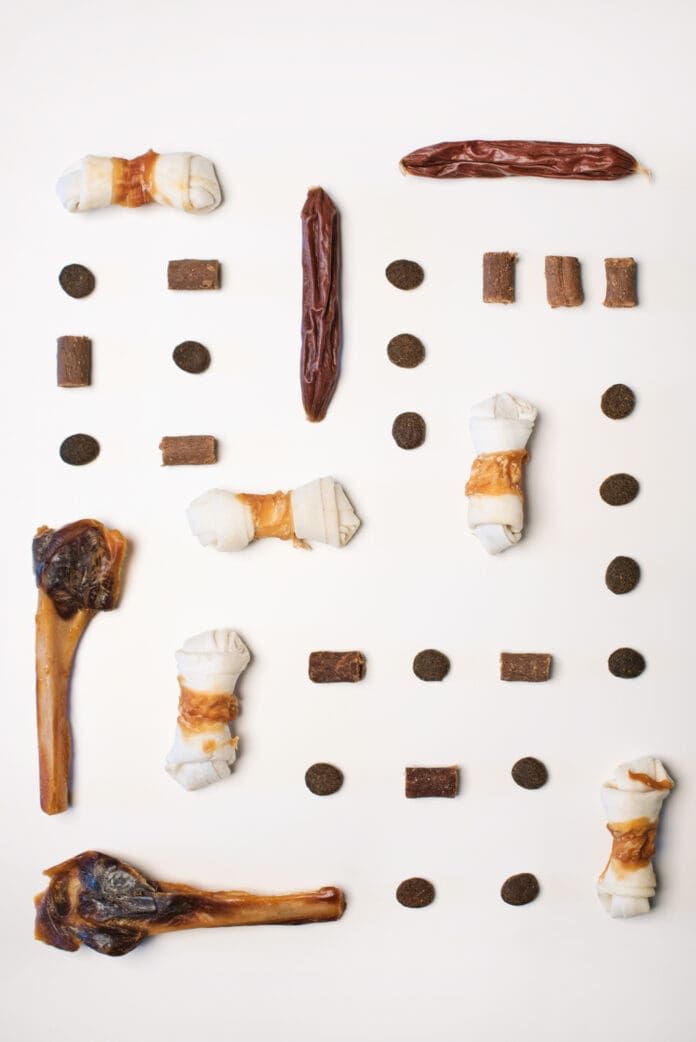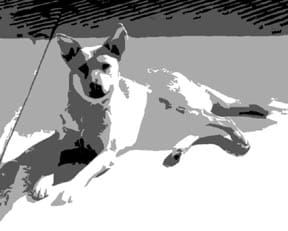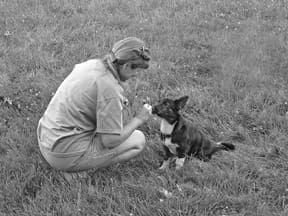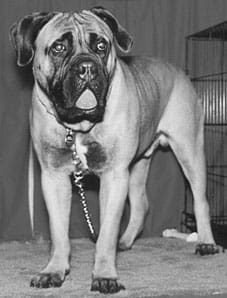SPOILED DOGS: OVERVIEW
1. Be the trainer when you are with your dog more often than you are the trainee.
2. Control the “good stuff” and generously share it with your dog when he offers polite behaviors.
3. Teach your dog that he needs to “Say please” in order to get the good stuff.
4. Prevent him from being rewarded for undesirable behaviors to avoid spoiling.
When a new client calls me seeking a private consultation, I often hear a litany of canine woes that includes: barking, chewing, digging, counter surfing, house soiling, jumping up, biting, running away, and other destructive and inappropriate behaviors. With amazing consistency, clients conclude by confessing that they allow their dogs on the furniture and feed them people food; then sheepishly claim, “I guess I’ve spoiled him.” I always respond with, “My dogs are allowed on the furniture and I feed them people food. If allowing dogs on the bed and feeding them human food equals spoiling, then I passionately believe that dogs should be spoiled.”
Contrary to what you may have read in some dog training books, letting your dog get on the sofa and feeding him real food does not mean he will turn into a raving dominant maniac-dog, nor does it teach him to drool at your dinner table. It simply means that you have made a conscious decision to grant him furniture privileges and provide him with a diet that goes beyond processed kibble. These deliberate choices on your part do not give rise to behavior problems. Spoiling a dog in a manner that leads to undesirable behaviors is something else entirely.
In her excellent new book, Click for Joy, author and clicker trainer Melissa Alexander says, “Spoiling occurs when you give something for nothing.”
I would add to her definition that spoiling also occurs when you allow behaviors to be rewarded that you will sooner or later come to regret. While a client who calls me about behavior problems may indeed have “spoiled” her dog, the problems are far more likely a result of giving a dog the opportunity to practice and be rewarded for inappropriate behavior than they are a result of furniture privileges and dietary selections.
Who Controls the Goods?
Whenever you are with your dog, one of you is training the other. The healthiest dog/human relationships generally occur when the human is the trainer and the dog the trainee the vast majority of the time. This means that the human controls most of the “good stuff” in the dog’s life, and decides when, where, and how the dog gets it. The dog can earn the good stuff by doing things that please the human.
Important note: The dog is not intrinsically trying to please the human. The dog is just doing whatever he needs to do to get the good stuff and thereby please himself. It is incidental to him that he pleases his human in the process.
I would identify a “spoiled” dog as one who is allowed to be the trainer more often than he is the trainee, when the resulting behaviors are damaging to the relationship. The spoiled dog does things that don’t please his human and gets the good stuff anyway.
This is the dog who “demand-barks” to go out, come back in, get a treat or a toy – and the human gives him what he wants because she knows the barking will just escalate if she doesn’t.
It’s the dog who digs at his owner’s arm for attention – and gets it. It’s the dog who jumps up on the bed next to the wife and growls at the husband when he tries to get in his side (especially if the husband then goes and sleeps on the sofa).
It’s the dog who wakes up at 3:00 a.m., barks to go out – even though he is a healthy adult dog well able to “hold it” all night – and then whines and barks in his crate when he comes back in until his humans let him out to spend the rest of the night in the bed with them. It’s the dog who drags his protesting owner around the block at the end of the leash, accosting every human, peeing on every bush, and eating every bit of garbage he can find along the way. You get the idea.
Get Your Dog to Say Please
You may have a new dog or pup and are determined not to spoil her. Or perhaps you are realizing that you have already made some mistakes and now have a dog who is slightly or seriously spoiled. In any case, a “Say please” program is a great way to prevent or overcome the challenges of living with a spoiled dog.
Also known as “Nothing in Life Is Free” or “No Free Lunch,” a “Say please” program teaches your dog that she must ask for good stuff – politely – by performing a desirable behavior, rather than by demanding – and getting – what she wants. “Sit” is the most versatile “Say please” behavior, and by far the easiest to install. Most dogs can learn to offer a sit in a few minutes or less (see “Sit Happens,” WDJ February 2001).
As soon as your dog learns that sitting is a very rewardable behavior, it’s a simple matter to wait for her to sit before bestowing good stuff on her. Breakfast time? Hold up her food dish and wait for her to sit; that’s a “Say please” behavior. Time for a walk? Sit gets you to attach the leash. Want to go out? Sitting politely makes the door open. Want to be petted? Dogs who sit get pets, treats, and attention.
You may be tempted to ask for the sit, but don’t! Instead, use a little body language if necessary; hold a treat, the food bowl, or your hand, up near your chest – and wait until she offers the sit of her own accord. Then work quickly to “fade” (progressively eliminate) the treat and body language. You want your dog to realize that she has to initiate the request for the good stuff.
One of the goals of positive reinforcement training is to create dogs who learn to control their own behavior, so that you don’t have to constantly tell them what to do. If you must usually tell your dog to sit, she won’t learn to “Say please” without being asked, and she won’t generalize her polite “Say please” behavior to other people and other situations.
Sit is not your only “Say please” option. It doesn’t matter so much what you ask her to do. What matters is that she learns she has to earn the good stuff, it doesn’t just happen gratuitously. You can use any desirable behavior that your dog can do easily – or a variety of behaviors in a variety of situations. Our Scottie, Dubhy, used to grumble at me from my office doorway when he wanted to go outside. I found this a little pushy and annoying, so I taught him to “Say please,” by coming into the office and lying quietly at my feet. Tucker, our cattle dog mix, does a lovely “Say please” play bow when he asks to go outside. And both of them “Say please” again by sitting politely at the door when I go to let them out.
Be Firm About It
“Sounds simple,” you may say, “but when I pick up my leash my dog Bonkers leaps and cavorts about, barks at the top of her lungs, and body-slams me. She’s not going to offer a sit!”
At this point Bonkers thinks that cavorting is what causes the door to open. It’s been working for a long time, so why wouldn’t she think that? It is certainly more challenging to reprogram an already-established undesirable behavior than it is to install the desirable one from the start, but it’s not impossible.
You can make it easier by separating the environmental cues that tell her it’s “walk-time.” Perhaps you always keep the leash on the hook by the front door and put it on her collar in the entryway when you take her for her daily walk at 5:30 pm after you get home from work. Try moving the leash to the kitchen drawer. At 7:00 in the morning on a day when you don’t have to rush off to work or school, take the leash out of the drawer and, using your “Sit” body language, help her to “Say please.” If she leaps and cavorts about uncontrollably, cheerfully say “Too bad!” set the leash on the counter and go about your morning kitchen business.
As soon as she calms down, pick up the leash again and try for another “Say please.” Every time she revs up, say “Too bad!” and set the leash down. Every time she calms down, restart the leash process. This teaches her that cavorting makes the leash go away, and that sitting makes the leash happen. You will probably be surprised by how quickly she figures it out. This is the opposite of what she learned in the past, so be patient.
As soon as she will stay reasonably calm when you pick up the leash, encourage her to sit so you can attach it to her collar. If she leaps up again when you start to clip it on, give her another cheerful “Too bad!” and set the leash down again. When she will remain sitting calmly as you attach the leash, take her to a different door from the one you usually exit through with her, and help her “Say please” at the door to make the door open. Take her out for at least a short walk as a reward.
Feel free to take breaks during the reprogramming process. Training sessions are generally most productive if they last no more than 10-15 minutes at a stretch. Some dogs (and humans!) do best with sessions that last 5 minutes or less. Try to take your breaks following one or more successes, rather than waiting until you or Bonkers are so frustrated you can’t take any more. If you find yourself getting frustrated, ask Bonkers to do something that she loves and does really well, and take a break after that.
Bonkers may need several short sessions to understand that she needs to sit and stay sitting in order to get the good stuff (leash and walk), or she may get it in one session. When she will reliably sit for you in the kitchen for the leash and at the alternate door to make it open, continue to put the leash on in the kitchen, but return to using the door that you normally use to take her out, at her regularly scheduled walk time. When that part of the walk routine is reprogrammed, take the leash out of the kitchen drawer, but walk to the entryway and clip it on her collar – after she does a polite “Say please” sit, of course. When she can do that calmly, hang the leash on its old hook by the door, and you’re back in business!
The Art of Dog Training
Most “spoiled” behaviors can be addressed by creating a reprogramming protocol similar to the one described above that teaches your dog to “Say please” in order to get whatever the good stuff is that she wants at the moment. Keep in mind, however, that many dogs will exhibit a behavior known as an “extinction burst,” which is akin to the temper tantrum that a toddler might throw when she doesn’t get her way.
For example, let’s say your dog is in the habit of barking at you to get you to let her outside. In your new reprogramming mode, you carefully ignore her when she barks by turning away from her, so that she is no longer rewarded for this undesirable behavior. Your dog knows that barking has gotten her what she wants in the past, and she can’t figure out why, all of a sudden, it’s not working now. So she tries harder, sure that if she just tries hard, loud, and long enough, it will work again.
Hearing the increased intensity and volume in the dog’s voice, you may become convinced that the new training program isn’t working and, tired of listening to the racket, open the door and let the dog out. You have just rewarded your dog’s increased level of barking, reinforcing “louder and longer” and making it that much more difficult to reprogram the barking behavior.
Simply ignoring the dog’s previously successful behavior leaves her frustrated and noisy, and stresses you both until you give in to her. This is where the “Say please” program is so valuable. Teaching her an alternative successful behavior gives her something else to do – an acceptable way to make good stuff happen. However, if you respond to her barking by asking her to sit and then letting her out, you are simply teaching a “behavior chain” of, “I bark, I sit, and then the door opens.” In order to avoid this dilemma, you must blend the science of behavior with the art of training.
Think About It
We tend to ignore our dogs when they are being polite, and pay attention to them when they are rude. That’s how they get to be spoiled in the first place – they learn that they have to be pushy to get what they want. If you are working to unspoil your dog or to prevent spoiling, you must keep your eyes open, watch for the polite “Say please” behavior to happen, and reward it a lot. When your dog does “Say please,” sometimes reward her with a pat on the head or a scratch behind the ear, sometimes with a yummy treat or a game of fetch, and sometimes by letting her out or giving her whatever other good stuff she politely asks for.
However, this doesn’t mean she always gets what she wants; the art of training is in finding the balance between controlling the good stuff and sharing it with your canine pal on your terms. In time, the new behaviors will be solidly programmed and you can reduce the rate of positive reinforcement without losing the new behaviors.
A “Say please” program won’t fix all behavior problems. The dog who doesn’t let hubby on the bed can certainly benefit from learning to “Say please,” but his owners may also need the assistance of a trainer/behaviorist to resolve the bed guarding. It will, without a doubt prevent a lot of problems from ever occurring in the first place, and even implemented after-the-fact, can help make the trainer/behaviorist’s job easier with the more challenging behavior problems.
If your dog doesn’t know how to “Say please,” perhaps it’s time to teach him. Then you can say, “Spoiled? Not my dog,” as he sits politely on the sofa next to you, smiling and eating pieces of carrot and chicken.
Pat Miller, WDJ’s Training Editor, is also a freelance author and Certified Pet Dog Trainer in Chattanooga, Tennessee. She is the president of the Board of Directors of the Association of Pet Dog Trainers, and published her first book, The Power of Positive Dog Training, in 2002.













